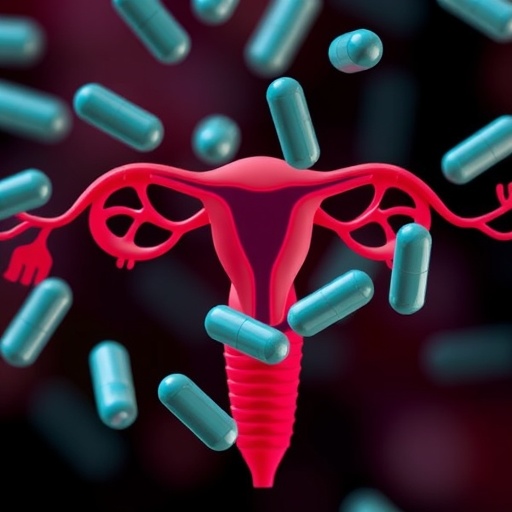Bentham Science Publisher’s latest scholarly release, Antibiotics and Reproductive Health, emerges as an essential compendium at the crossroads of pharmacology, medicine, and reproductive biology. This publication sheds unprecedented light on the intricate interactions between antibiotic treatments and female reproductive health, a subject that has garnered significant attention in clinical and research settings. It meticulously examines how the administration of antibiotics, long hailed for their efficacy in combating infections, can inadvertently influence fertility parameters, gestational development, endocrine functions, and neonatal well-being. The text further delves into the complex dynamics of antibiotic resistance and disruptions to the human microbiome, topics that resonate deeply within public health dialogues worldwide.
Central to this volume’s importance is its rigorous exploration of antibiotic-induced reproductive toxicity, an area that has historically been underrepresented despite growing clinical evidence. Through a synthesis of both clinical trial outcomes and experimental data, the book articulates the mechanisms by which different classes of antibiotics may impart deleterious effects on ovarian and uterine tissues, sperm viability, and embryonic development. Moreover, the discussion extends to microbiome perturbations driven by broad-spectrum antibiotic use, which are increasingly linked to hormonal imbalances and adverse reproductive outcomes. This intersectional analysis represents a significant step forward in understanding the collateral consequences of antimicrobial therapy beyond traditional infectious disease paradigms.
One of the most compelling facets of the book is its comprehensive coverage of antibiotic safety during pregnancy—a subject fraught with clinical dilemmas and ethical challenges. It rigorously evaluates the teratogenic potentials of various antibiotic agents, detailing how timing, dosage, and pharmacodynamics intersect to influence fetal development. Neonatal outcomes are assessed with a long-term perspective, emphasizing not only immediate birth complications but also generational effects that may manifest later in life. This multifaceted lens encourages clinicians and researchers to rethink antibiotic stewardship within obstetrics, fostering improved risk assessment and patient-centered care protocols.
The volume also addresses a critical public health concern: the burgeoning crisis of antibiotic resistance and its implications for reproductive health. Resistance mechanisms reduce the efficacy of standard treatments, thereby prolonging infections that may directly or indirectly impair reproductive organs. Furthermore, resistant bacteria pose unique challenges for maternal health, particularly in perinatal infections, where treatment options are limited. The book’s chapters on resistance comprehensively discuss microbial genetics, horizontal gene transfer, and environmental reservoirs, providing a nuanced understanding of how resistance intersects with reproductive medicine.
In addition to pharmacological impacts, the text delves into the human microbiome’s pivotal role in reproductive physiology. Antibiotic administration alters the delicate balance of microbial populations within the gut, vagina, and reproductive tract, which can disrupt immune homeostasis and hormonal regulation. Emerging research underscored in this volume links these microbiome shifts to conditions such as polycystic ovary syndrome, endometriosis, and infertility. Such insights underscore a paradigm shift: appreciating microbiota as integral components of reproductive health rather than mere bystanders.
The editorial stewardship by Dr. Faiza Rao and Dr. Anam Rao brings invaluable expertise to the discourse. Dr. Faiza Rao’s extensive background in genetics and reproductive health enriches the genetic and molecular analyses, while Dr. Anam Rao’s clinical focus on antibiotic resistance and environmental health provides a pragmatic lens grounded in frontline medical challenges. Their combined efforts have ensured that the volume balances cutting-edge science with clinical applicability, resonating across disciplines.
This reference is not only geared towards clinicians and pharmacists but also offers a vital resource for researchers and students dedicated to reproductive medicine and pharmacology. Its careful integration of experimental models and clinical observations offers readers a robust framework for envisioning future investigations and therapeutic innovations. Importantly, the text emphasizes evidence-based practice, encouraging healthcare professionals to navigate antibiotic prescribing with nuanced appreciation of reproductive risks.
In the context of public health policy, the book’s detailed assessment of antibiotic impacts provides an essential foundation for crafting guidelines that safeguard reproductive outcomes while combating infectious diseases. Policymakers are urged to consider reproductive toxicity data alongside antimicrobial stewardship initiatives to ensure holistic health protection. This compendium also advocates for enhanced surveillance systems to monitor antibiotic effects in reproductive populations, addressing current gaps in data collection and regulatory oversight.
Technological advances in molecular biology, genomics, and microbiome science are well represented throughout the volume, illustrating how these tools are revolutionizing our understanding of antibiotic-reproductive system interactions. High-throughput sequencing and bioinformatics analyses have unveiled previously unrecognized pathways of toxicity and resistance, facilitating more precise risk stratification. These developments promise to refine clinical decision-making and inspire personalized medicine approaches, enabling tailored interventions that minimize harm while maximizing therapeutic efficacy.
Beyond the scientific community, the societal relevance of this work cannot be overstated. Women’s health advocates, reproductive rights organizations, and patient groups will find in this book a compelling argument for increased awareness and education regarding antibiotic use and reproductive well-being. As the global burden of infertility rises, understanding modifiable pharmaceutical risks becomes imperative, reinforcing the need for informed consent and shared decision-making in reproductive healthcare.
In sum, Antibiotics and Reproductive Health stands as a landmark publication, intricately documenting the multifaceted effects of antibiotics on reproductive health. It challenges existing clinical paradigms, fosters interdisciplinary dialogue, and sets a new standard for research integration. With its clear, evidence-based narrative, this volume is poised to influence both scientific inquiry and clinical practice, ultimately aiming to enhance reproductive safety amid the complex landscape of modern medicine.
Subject of Research: The intersection of antibiotic usage and its effects on female reproductive health, including fertility, pregnancy, microbiome alterations, and antibiotic resistance.
Article Title: Antibiotics and Reproductive Health: Navigating Therapeutic Benefits and Risks
Web References: http://dx.doi.org/10.2174/97898153136281250101
Keywords: Antibiotics, Bactericidal antibiotics, Broad spectrum antibiotics, Pregnancy, Medications, Antifungal agents, Human biology, Developmental biology, Reproductive system, Reproductive biology




